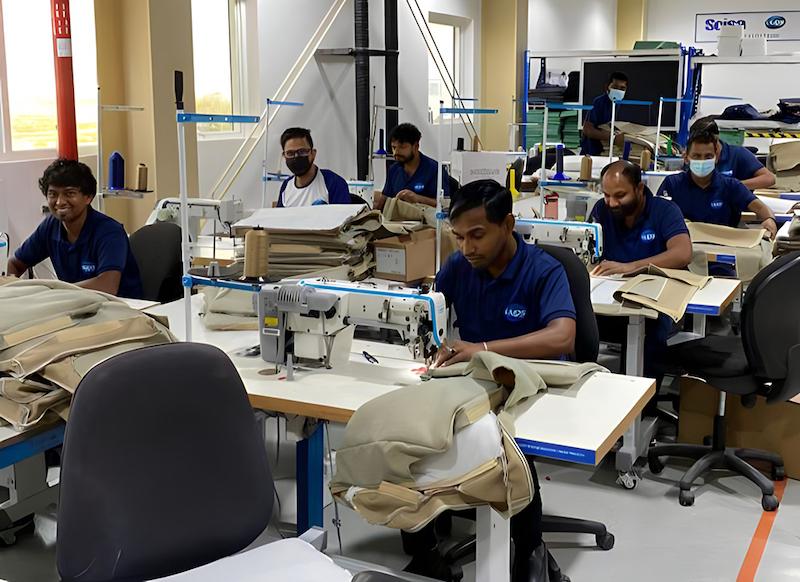
Mexico-based Soisa Aircraft Interiors is boosting its footprint in Dubai to reduce lead times and grow business with Middle Eastern carriers. The growth is being driven in part by its support for ambitious cabin retrofit projects by carriers such as Emirates and Etihad Airways.
Earlier this year, Soisa opened a new facility in Dubai South with approximately 40 employees, including 37 specialized in cutting, sewing and lamination processes for aircraft interior materials. It is now expanding to a facility in Dubai South more than twice as large as its current operation.
According to Soisa CEO Jacobo Mesta, the company is aiming to speed up time to market for interior products in the region. “Everybody wants it by yesterday,” he says, noting that the manufacturing process for fabric or leather takes 12 weeks, so there are currently lead times of at least 16 weeks for interior products. “When the airlines are thinking about [cabin upgrades], we should already be asking for the material. Because once they do make a decision, they want it now, and that’s when the supply chain gets into trouble.”
One way in which Middle Eastern airlines are speeding up supply chain bottlenecks is through changing ordering habits. “One of the biggest trends we’re seeing is that the airlines are moving more toward buying directly from the manufacturers and not from the OEMs,” Mesta says. “That’s one thing that makes the cycle much faster. The lead times and costs are reduced.”
Mesta says Middle Eastern carriers are also opting for upgraded interior designs. “We’ve been seeing a lot of lamination, which gives you a little bit more aesthetic on the back, bottom and headrest of your seat, and it’s a bit more comfortable, as well,” he says, noting that Emirates, Etihad and flydubai have all been moving toward this trend. “There’s also a trend in using a lot of fabric for long-haul flights, and we’re seeing Etihad add some piping on the stich lines on the sides of the [seat] backs and headrests.”
However, in regions such as Europe and the U.S., Mesta says carriers are moving away from fabrics and opting instead for synthetics or engineered leather due to sustainability and maintainability concerns. “With synthetics and engineered leather, it’s a much easier cleaning process. For example, if fabric starts to get filled with water or other products, it starts getting heavier, and you don’t want any heavy weight on the plane,” he says.
Although Soisa is seeing growing pressure from customers about supply chain sustainability concerns, Mesta says it is constrained because customers ultimately choose which materials they want to use. “Our big issue was we were having a lot of scrap and having to send it to a landfill. When you add any adhesives or fire retardant it gets more complicated to recycle, as well,” he says.
In response, Soisa has launched several sustainability initiatives in Mexico. Mesta says around 80% of its facility in Chihuahua runs on clean energy generated by solar panels. It has also launched a unique initiative called “From Waste to Wonder” in which it donates scrap materials such as leather, fabric, velcros and threads to a local indigenous group, the Tarahumaras. Soisa worked with the local government to train Tarahumara individuals to cut and sew leather products such as wallets, aprons and tablecloths, which they can then sell for additional income.
Mesta says aircraft lessor Avolon has helped support the initiative since its launch. “When they change from one leasing company to another, they have to throw away all the dress covers and cushions,” he says. “They’re sending us all the dress covers and cushions, and they donated some equipment for sewing, as well.”
Soisa recently expanded the program to local prisons, where inmates can learn how to create products that they can sell to generate income for their families and for their own needs while incarcerated. The program is currently running in two prisons in Mexico, and Mesta says the company is working to expand it to other prisons.
Meanwhile, the interiors specialist is also engaging with the advanced air mobility segment. It is working with electric vertical-takeoff-and-landing developer Archer to design a new seat for its aircraft, “and those are much trendier and much different than seats on commercial aircraft right now,” Mesta says. He adds that Soisa expects commercial space to be another interesting market for interiors specialists.
